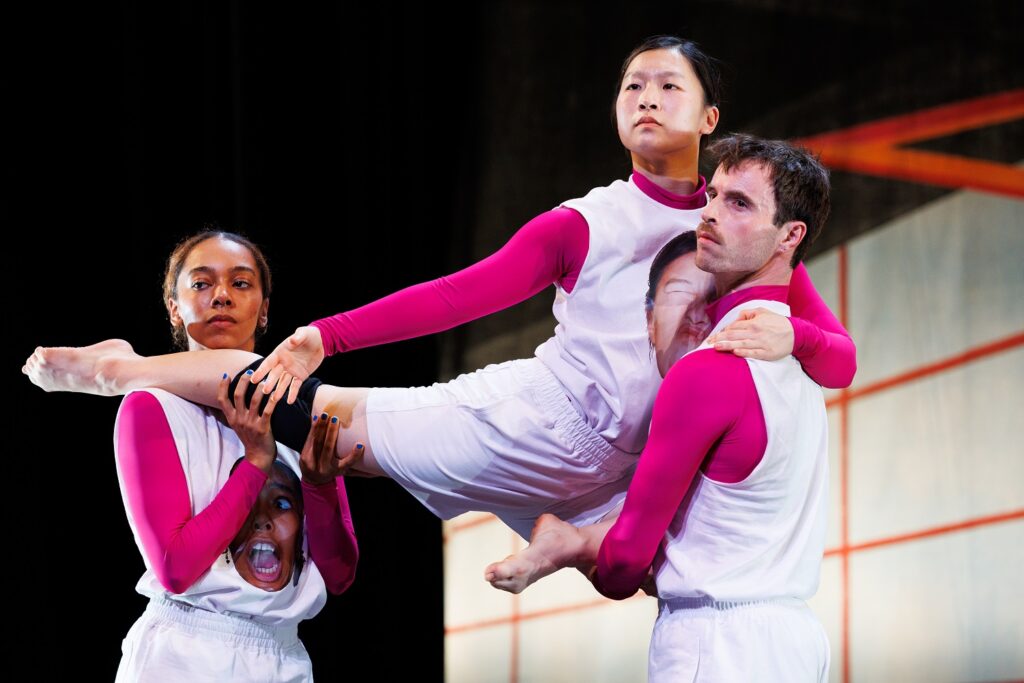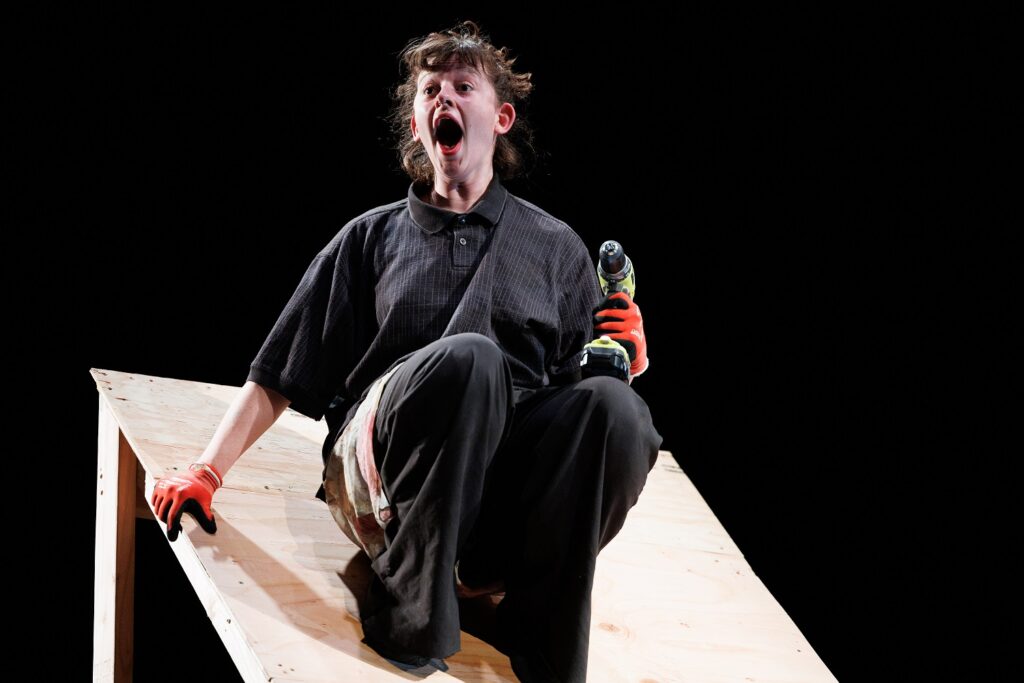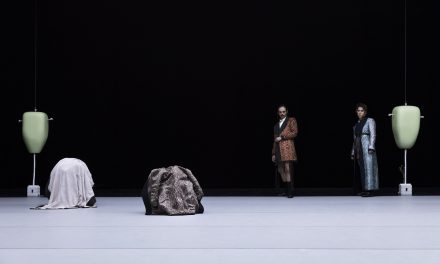Pillows are thrown to the ground and pummeled. Clashing ideas search for harmony as an ensemble of dancers assimilates to their second choice. Tables are shoved across the floor and wooden planks are thrown across the stage.
In REDCAT’s final week of this year’s NOW Festival, Mallory Fabian, Bret Easterling and Kensaku Shinohara bring violence to the stage in the best possible way. As a curated program, NOW Festival’s third week, which ran from Nov. 21 – 23, is unapologetically loud — metaphorically and literally. The trio of artists are determined to get their ideas across, succeeding most when they let the fury embody the performers. Underneath the movement is a hearty message, leaving you with questions about the world outside REDCAT’s doors.

REDCAT Now Festival 2024 – (L-R) Chris Louis, Clementine Gamson, Chris Rouse, Mallory Fabian in “I Hate Women” – Photo by Angel Origgi.
Fabian’s “I Hate Women” is a multidisciplinary work of dance, theater and boxing that interrogates some of the unspoken complexities of platonic relationships between women. Set in a boxing ring held by the men (IIMBI, Leland Ireland, Roberto Antonio Martin, Tauhid Price, Daniel A. Stevens), Fabian and Clementine Gamson enter to fight. With Chris Louis and Chris Rouse as their coaches, they attempt to cause the other harm — first by moping then by giggling and tucking hair behind their ears. Meanwhile, Louis and Rouse whisper supportive instructions to them: “Use a right hook, yeah, yeah, watch out.”

REDCAT Now Festival 2024 – (L-R) Mallory Fabian, Clementine Gamson in “I Hate Women” – Photo by Angel Origgi.
Fabian puts every stereotype perpetuating misogyny, patriarchy and homophobia center stage. It’s used as a weapon against the other woman in the ring. Fabian pairs movement and dialogue masterfully in action-packed moments. When Gamson steps atop a stool, streamlining her thoughts while trying on a pair of pants, Fabian stays on the floor, moving with the progression of the dialogue. Switching positions, Fabian talks about how women can support each other. Momentum builds. The energy loses its hold when Fabian and Gamson stand still, verbalizing a literal translation of what was embodied metaphorically in the space. Fabian shares how the two women’s first impressions of each other were completely off. Moments like this are special but interrupt the tone Fabian solidified in the confines of the brawl.
“I Hate Women” makes up for the loss of momentum when the duo moves across the ring, following patches of rectangular light (crafted by lighting designer Chu-Hsuan Chang) spotlighting portions of the stage. One at a time, they dance in a patch to find their individual footing. That is until they land on the same patch of light. In a stark collision, it is clear that their relationship has turned sour once again, leaving you with more questions about sustaining platonic relationships.
A fouetté turn. A screaming face. A pop of the hip. Easterling’s “On Second Thought” asks what would happen if we went with our second thought rather than the first one, resisting habitual patterns of improvisation and movement creation. This ideology is slowly introduced, beginning with one person (Stephanie Dai) before bringing on the rest of the ensemble (Easterling, Bella Allen, Marirosa Crawford, Julia Eichten, Austin Tyson, Kevin Zambrano). They move slowly, shifting from second thought to second thought.

REDCAT Now Festival 2024 – Austin Tyson (above), Marirosa Crawford in “On Second Thought” by Brett Easterling – Photo by Angel Origgi.
The work forces dancers to think outside the box, refusing to stick to a singular aesthetic. The result is a fusion of styles. In one instance, the ensemble sways the hips, creating a groove. In the next, they reach forward, dramatically, as if yearning within a lyrical phrase. Second thoughts often bring humor. When Eichten enters, moving and stretching out words like “caaaaaravan” and “gaaaaaaay,” Dai enters to let the audience in on the process. As she verbalizes how the section was created, she makes her second choice: telling it to us in Mandarin. The intention of the second choice is woven into every bit of the work. The tension between each thought and execution keeps you on your toes, looking closely at every detail.

REDCAT Now Festival 2024 – (L-R) Marirosa Crawford, Stephanie Dai, Austin Tyson in “On Second Thought” by Brett Easterling – Photo by Angel Origgi.
The best detail is Easterling’s internal research in the back corner. While the ensemble weaves on and off stage, often in a beautifully chaotic manner, he moves in an isolated manner upstage, choreographing with his thoughts. He operates like a map — showing the audience the process behind the choreography in front of them — and a clock — documenting time passing.

REDCAT Now Festival 2024 – (Dancers facing forward)Bella Allen, Kevin Zambrano in “On Second Thought” by Brett Easterling – Photo by Angel Origgi.
It ends with Easterling’s final presentation of the phrase he rehearsed throughout the entire piece — the perfect satisfying punctuation to “One Second Thought.”

REDCAT Now Festival 2024 – Jessica Hemingway in “tired music concert” by Kensaku Shinohara – Photo by Angel Origgi.
The last, and most violent, piece of the program was Shinohara’s “sorry I did not prepare anything today: I will give up my art because I cannot make money and feel embarrassed and also I am trying to be a good father,” or “tired music concert.” The piece is an irreverent inside look into Shinohara’s life as a father, artist and immigrant. He begins in front of a curtain upstage, admitting that he prepared nothing and only has 25 minutes (which becomes 20 by the end of his introduction). He leaves it up to his ensemble of performers (Jessica Hemingway, Jacob Wolff, Lillie Yokom, Max Martin and Joe Shinohara — his toddler son) to make up the rest.

REDCAT Now Festival 2024 – Joe Shinohara (top), Jessica Hemingway in “tired music concert” by Kensaku Shinohara – Photo by Angel Origgi.
The piece is absolute chaos. When the curtain falls, we see a giant wooden ramp downstage with wooden planks and seemingly random items strewn across the floor. Martin and Yokom repeat a dance phrase across the stage. Hemingway and Wolff pick up pieces of wood to build and destroy the space. Dylan Marx’s music resounds.
Joe’s addition to the wreckage is an unexpected twist. He follows the performers and climbs on the structures, giggling and smiling even when he accidentally tumbles. His innocence and pure joy bring a smile to the face. Shinohara quickly destroys this when the chaos ends and the lights go out. There’s shuffling and panting, then the lights go up to the performer (minus Joe) naked and laying feet to shoulder up the ramp. The audience gasps. The crew makes their way on and off the wooden ramp, whether by walking or sliding into a clump of limbs at the bottom.

REDCAT Now Festival 2024 – Jacob Wolff in “tired music concert” by Kensaku Shinohara – Photo by Angel Origgi.
Shinohara’s work is haunting. Unlike the other pieces, he plays with every extremity of our emotions. His work is a strong conclusion to the entire festival. Although it is presented as him raising his white flag in surrender to the business side of the arts, the final presentation is ironically a well-crafted punch.
“When you treat me like a person, I’ll act like a person,” Hemingway shouts into a mic in the final moments of “tired music concert.” She’s ranting on a Zoom call with what seems to be an institution, trying to get the person on the other end to stop sharing their screen and listen to her explain the work. She soon spirals, muffling sweet nothings into the wall before screaming outside the theater. The ranting ends and there is silence. She sips the beer. She hits the vape. She puts back on her clothes. Everything settles. There’s something so deeply satisfying in this release. “tired music concert” puts institutions in the hot seat, proclaiming a lot of what is said behind closed doors by artists trying to get their work made with respect and proper compensation.

REDCAT Now Festival 2024 – Max Martin in “tired music concert” by Kensaku Shinohara – Photo by Angel Origgi.
REDCAT week three leaves you with questions about the work we consume and the artists behind them. Fabian provokes our understanding of societal roles and interpersonal relationships. Easterling makes us question, “What if?” Shinohara exposes everything in between, making you wonder how we all got in the same room that evening.
To learn more about REDCAT, please visit their website.
Written by Steven Vargas for LA Dance Chronicle.
Featured image: REDCAT NOW Festival 2024 – (L-R) Clementine Gamson, Chris Louis, Mallory Fabian, Chris Rouse in “I Hate Women” by Mallory Fabian – Photo by Angel Origgi.









